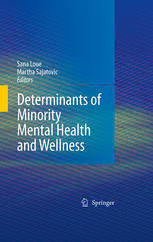
Determinants of Minority Mental Health and Wellness PDF
Preview Determinants of Minority Mental Health and Wellness
Determinants of Minority Mental Health and Wellness Sana Loue Martha Sajatovic l Editors Determinants of Minority Mental Health and Wellness 1 3 Editors SanaLoue MarthaSajatovic CaseWesternReserve UniversityofCleveland Cleveland,OH Cleveland,OH [email protected] [email protected] ISBN978-0-387-75658-5 e-ISBN978-0-387-75659-2 DOI10.1007/978-0-387-75659-2 LibraryofCongressControlNumber:2008939085 #SpringerScienceþBusinessMedia,LLC2009 Allrightsreserved.Thisworkmaynotbetranslatedorcopiedinwholeorinpartwithoutthewritten permissionofthepublisher(SpringerScienceþBusinessMedia,LLC,233SpringStreet,NewYork, NY10013,USA),exceptforbriefexcerptsinconnectionwithreviewsorscholarlyanalysis.Usein connectionwithanyformofinformationstorageandretrieval,electronicadaptation,computer software,orbysimilarordissimilarmethodologynowknownorhereafterdevelopedisforbidden. Theuseinthispublicationoftradenames,trademarks,servicemarks,andsimilarterms,evenifthey arenotidentifiedassuch,isnottobetakenasanexpressionofopinionastowhetherornottheyare subjecttoproprietaryrights. Whiletheadviceandinformationinthisbookarebelievedtobetrueandaccurateatthedateof goingtopress,neithertheauthorsnortheeditorsnorthepublishercanacceptanylegalresponsibil- ityforanyerrorsoromissionsthatmaybemade.Thepublishermakesnowarranty,expressor implied,withrespecttothematerialcontainedherein. Printedonacid-freepaper springer.com Preface The United States is experiencing a dramatic shift in demographics, with minorities comprising a rapidly growing proportion of the population. It is anticipated that this will likely lead to substantial changes in previously established values, needs, and priorities of the population, including health and mental health for individuals, families, and society at large. This volume focusesondeterminantsofminoritymentalhealthandwellness.Thisemphasis necessarilyraisesthequestionofjustwhoisaminorityandhowisminorityto bedefined. The term has been defined in any number of ways. Wirth (1945, p. 347) offeredoneoftheearliestdefinitionsofminority: We may define a minority as a group of people who, because of their physical or culturalcharacteristics,aresingledoutfromtheothersinthesocietyinwhichtheylive fordifferentialandunequaltreatment,andwhothereforeregardthemselvesasobjects of collective discrimination. The existence of a minority in a society implies the existenceofacorrespondingdominantgroupenjoyinghighersocialstatusandgreater privileges. Numerousscholarshaveassertedthatthecentralfeatureofaminoritygroup is the power deficiency relative to that group (Blalock, 1960; Dworkin & Dworkin, 1982; Geschwender, 1978; Wilson, 1973) and the resulting oppression of one group by another. This imbalance of power may be manifested in the economic, political, and social domains of life (Ashmore, 1970; Barron, 1957; Howard, 1970; Kinloch, 1979; Ramaga, 1992; Wagley & Harris, 1958) through overt or more subtle forms of influence, exploitation, domination, oppression, and discrimination (Meyers, 1984; Ramaga, 1992). This power imbalance allows the establishment and maintenance of both controlanddependency(Manderson,1997). Within this paradigm, it is the relative power or lack of it that is determinative of minority group status, rather than the numerical superiority orinferiorityofagroup(Meyers,1984;Ramaga,1992).Thedisempowerment andoppressionoftheblackmajoritybyawhiteminorityinSouthAfricaduring theyearsofapartheidservesassuchanexample.Somewriters,however,have refusedtocharacterizeagroupasaminorityifthegroupislargerinrelativesize v vi Preface withinthepopulationunderdiscussionorifthegrouphasnodesiretopreserve the characteristics which are believed to render it distinct (Anon, 2007; Schermerhorn,1964). Characteristicsthathavebeenlinkedtominoritygroupidentityincludesex, sexualorientation,disability,ethnicity,nationality,race(withoutdebatingthe validityofthatconcept),language,culture,andreligion(Baron&Byrne,1977; Barron, 1957; Hacker, 1951; Pap, 2003; Rose, 1964; Wagley & Harris, 1958), althoughreligionhasrarelybeenreliedupontodefineaminorityintheUnited States(Minority,2008).Onescholarexplained, Minoritiesaresub-groupswithinaculturewhicharedistinguishablefromthedominant groupbyreasonsofdifferencesinphysiology,language,customs,orculturepatterns (includinganycombinationofthesefactors).Suchsub-groupsareregardedasinherently differentandnotbelongingtothedominantgroups;forthisreasontheyareconsciously orunconsciouslyexcludedfromfullparticipationinthe lifeoftheculture ....Some minoritiesarephysicallydifferentbutculturallysimilarwithrespecttothemajority... othersareculturallydifferentbutphysicallysimilar...andstillothersarebothculturally andphysicallydifferent....Theculturaland/orphysicaldifferencesbetweenmajority andminorityactuallymaybesominuteastomakeitimpossibletodetectbysimple observationwhoisamemberoftheminorityandwhoisamemberofthemajority. (Schermerhorn,1949,p.5) As such, an individual essentially inherits his or her status as a minority group member and cannot change that status unless the status of the group itself should change or he or she denies group membership, something that is not possible in the case of skin color or biological sex (Harris, 1959). The transformation of the Catholic population in New York from a despised and persecuted minority to a powerful force in the City’s economic and political infrastructureservesasanexampleofhowthestatusofaminoritygroupmay changeovertime(Collins,2008). Accordingly,eachofthechapterswithinthisvolumeaddressesmentalhealth andmentalillnesswithintheframeworkofoneormoresuchgroups.Sajatovic and colleagues lay the foundation for this exploration with their opening chapter that examines the meanings of mental health and wellness. The chapters that follow relating to urbanization, law, migration, media, health care systems, and systems of support examine the impact of these systems on minorityhealthandwellness.Community-levelandfamily-levelandfactorsare discussed in the subsequent chapters that focus on religion, cultural perspectives of healing, racism, psychoeducation, and family dynamics. The importance of individual-level characteristics is addressed in the chapters relating to gender, socioeconomic status, genetics, substance use, cognitive functioning, and stress and resilience. The volume concludes with an examination of methodologic difficulties inherent in the conduct of research relating to mental health and wellness among minority groups and directions forfutureresearch. Several themes emerge consistently throughout these chapters. Foremost among these is the discrimination encountered by members of minority Preface vii groupsdefinedonthebasisoftheirskincolor,ethnicity,biologicalsex,sexual orientation, gender, and language. It is equally apparent, however, that individuals face prejudice, hostility, and discrimination by virtue of their mental illness alone. Consequently, individuals who both are members of one or more defined minority groups and have a mental illness diagnosis may be multiplystigmatized(Capitanio&Herek,1999;Herek,1999;Herek&Capitanio, 1999;McBride,1998;Reidpath&Chan,2005). Second, the discussion focusing on the larger environmental context of mental health and wellness underscores the complex nature of mental health andillnessandthefailureofmanyofoursystems,includingmedia,healthcare, housing,andlaw,toprovideadequatesupporttoindividualstoenablethemto functiontotheirmaximumabilitywithinoursociety. Finally,itisevidentfromthesechaptersthatminorityindividuals,families, and communities often possess remarkable strengths that often remain unidentified or underutilized in their efforts to address life’s challenges. Guarnaccia’s final chapter highlighting directions for future research challenges us to identify mechanisms to address the deficiencies within our systems and to maximize the resources potentially available to individuals at thelevelsoftheindividual,family,andcommunity. Cleveland,OH SanaLoue MarthaSajatovic References Anon.(2007).Redefiningminorityundesirablecontroversy.TheStatesman(India),April15. Retrieved May 21, 2008 from http://www.lexis.com/us/academic/delivery/PrintDoc.do? fromcart-false$dnldFilePath=%2F1-n%...[subscriptionrequired]. Ashmore,R.D.(1970).Theproblemofintergroupprejudice.InB.E.Collins(Ed.),Social psychology(pp.246–296).Reading,Massachusetts:Addison-Wesley. Baron,R.A.,&Byrne,D.(1977).Socialpsychology:Understandinghumaninteraction(2nd ed.).Boston,Massachusetts:BaconandAllyn. Barron,M.L.(Ed.).(1957).Americanminorities:Atextbookofreadingsinintergrouprela- tions.NewYork:Knopf. Blalock,H.M.Jr.(1960).Apoweranalysisofracialdiscrimination.SocialForces,39,53–59. Capitanio,J.P.,&Herek,G.M.(1999).AIDS-relatedstigmaandattitudestowardsinjecting drug users among black and white Americans. American Behavioral Scientist, 42(7), 1148–1161. Collins,G.(2008).Persecutedtopowerful:ExhibitingahistoryofNewYork’sCatholics.New YorkTimes,May15,sec.B,p.2,col.0. Dworkin, A. G., & Dworkin, R. J. (Eds.). (1982). The minority report: An introduction to racial,ethnicandgenderrelations(2nded.).NewYork:Holt,Rinehart&Winston. Geschwender,J.A.(1978).RacialstratificationinAmerica.Dubuque,Iowa:WilliamC.Brown. Hacker,H.M.(1951).Womenasaminoritygroup.SocialForces,30(1),60–69. Harris,M.(1959).Caste,class,andminority.SocialForces,37(3),248–254. Herek,G.M.(1999).AIDSandstigma.AmericanBehavioralScientist,42(7),1106–1116. viii Preface Herek, G. M., & Capitanio, J. P. (1999). AIDS stigma and sexual prejudice. American BehavioralScientist,42(7),1130–1147. Howard,J.R.(Ed.).(1970).Awakeningminorities:AmericanIndians,MexicanAmericans, PuertoRicans.Chicago:Aldine. Kinloch, G. C. (1979). The sociology of minority group relations. Englewood Cliffs, New Jersey:Prentice-Hall. Manderson,L.(1997).Migration,prostitutionandmedicalsurveillanceinearlytwentieth- centuryMalaysia.InL.Marks&M.Worboys(Eds.).Migrants,minorities,andhealth (pp.49–69).London:Routledge. McBride, C. A. (1998). The discounting principle and attitudes towards victims of HIV infection.JournalofAppliedSocialPsychology,28(7),595–608. Meyers,B.(1984).Minoritygroup:Anideologicalformulation.SocialProblems,32(1),1–15. Minority. (2008). In Encyclopedia Britannica. Last accessed March 19, 2008; Available at EncyclopediaBritannicaOnline,http://www.britannica.com/eb/article-9052878 Pap,A.L.(2003).EthnicizationandEuropeanidentitypolicies:Window-shoppingwithrisks. DialecticalAnthropology,27,227–248. Ramaga, P. V.(1992). Relativity ofthe minority concept.Human Rights Quarterly,14(1), 104–119. Reidpath,D.D.,&Chan,K.Y.(2005).Amethodforthequantitativeanalysisofthelayering ofHIV-relatedstigma.AIDSCare,17(4),425–432. Rose,A.M.(1964).Raceandminoritygrouprelations.InJ.Gould&W.L.Kolb(Eds.).A dictionaryofthesocialsciences(pp.570–571).NewYork:FreePress. Schermerhorn, R. A. (1949). These our people: Minorities in American culture. Boston, Massachusetts:D.C.Heath. Schermerhorn, R. A. (1964). Toward a general theory of minority groups. Phylon, 25(3), 238–246. Wagley,C.,&Harris,M.(1958).MinoritiesintheNewWorld.NewYork:ColumbiaUniversity Press. Wilson, W. J. (1973). Power, racism, and privilege: Race relations in theoretical and socio- historicalperspective.NewYork:Macmillan. Wirth,L.(1945).Theproblemofminoritygroups.InR.Linton(Ed.).Thescienceofmanin theworldcrisis(pp.347–372).NewYork:ColumbiaUniversityPress. Contents 1 HealthandWellness...................................... 1 SusanHattersFriedman,JoyStankowski,andMarthaSajatovic 2 CityLivingandMentalHealthinHistory..................... 15 SandroGalea,EmilyGoldmann,andAndreaMaxwell 3 MentalHealth,MentalHealthCourts,andMinorities ........... 39 LaraNochomovitzandFranklinJ.Hickman 4 MigrationandMentalHealth .............................. 57 SanaLoue 5 Media,Minorities,andtheStigmaofMentalIllness............. 73 SandraS.Swantek 6 MinorityMentalHealthandWellness:APerspectivefrom HealthCareSystems ..................................... 89 SiranM.Koroukian 7 SocialSupport,MentalHealth,Minorities,andAcculturativeStress 125 DeborahGoebert 8 ReligionandMentalHealthAmongMinoritiesandImmigrants intheU.S. ............................................. 149 Anahı´ ViladrichandAnaF.Abraı´do-Lanza 9 CulturalConsiderationsRegardingPerspectivesonMentalIllness andHealing ............................................ 175 DeclanT.BarryandMarkBeitel 10 GenderandMinorityMentalHealth:TheCaseof BodyImage ............................................ 193 LauraSimonelliandLeslieJ.Heinberg ix x Contents 11 FamilyDeterminantsofMinorityMentalHealth andWellness............................................ 221 StevanWeineandSaifSiddiqui 12 Family-FocusedPsychoeducationalProgramsforMinorities withSeriousMentalIllness ................................ 255 AmyWeismandeMamani,RadhaDunham,StephanieAldebot, NaomiTuchmanandStephanieWasserman 13 SocioeconomicStatus:RisksandResilience.................... 273 LaraM.Stepleman,DustinE.Wright,andKathrynA.Bottonari 14 PsychiatricGenetics-AnUpdate............................. 303 PrashantGajwani 15 SubstanceAbuseinMinorityPopulations ..................... 313 W.A.VegaandA.G.Gil 16 NeurocognitiveTestingofMinoritiesinMentalHealth Settings ............................................... 335 AmirPorehandAlyaSultan 17 StressandResilience ..................................... 349 AnnaMariaAguirreMcLaughlin,LisaStinesDoane, AliceL.CostiucandNorahC.Feeny 18 MethodologicalChallengesinResearchontheDeterminantsof MinorityMentalHealthandWellness........................ 365 PeterGuarnaccia Index..................................................... 387 Contributors AnaF.Abraı´do-Lanza MailmanSchoolofPublicHealth,Columbia University,NewYork,NY AnnaMariaAguirreMcLaughlin CaseWesternReserveUniversity,Cleveland, Ohio StephanieAldebot UniversityofMiami,CoralGables,Florida DeclanBarry,Ph.D. YaleUniversitySchoolofMedicine,NewHaven,CT MarkBeitel,Ph.D. YaleUniversitySchoolofMedicine,NewHaven,CT KathrynA.Bottonari,M.A.,M.S. MedicalCollegeofGeorgia,Augusta,GA AliceL.Costiuc CaseWesternReserveUniversity,Cleveland,OH RadhaDunham,M.S. UniversityofMiami,CoralGables,Florida NorahC.Feeney,Ph.D. CaseWesternReserveUniversity,Cleveland,OH SusanHattersFriedman,M.D. CaseWesternReserveUniversity,Schoolof Medicine,Cleveland,OH PrashantGajwani,M.D. UniversityHospitalsCaseMedicalCenter,Schoolof Medicine,CaseWesternReserveUniversity,Cleveland,OH SandroGalea,M.D.,Dr.P.H. UniversityofMichigan,SchoolofPublic Health,AnnArbor,MI AndresG.Gil,Ph.D. FloridaInternationalUniversity,OfficeofResearchand UniversityGraduateSchool,Miami,FL DeborahGoebert,Dr.P.H. UniversityofHawaii,JohnA.BurnsSchool ofMedicine,Honolulu,Hawaii EmilyGoldmann,M.P.H. UniversityofMichigan,SchoolofPublicHealth, AnnArbor,MI PeterGuarnaccia,Ph.D. InstituteforHealth,HealthCarePolicy,andAging Research,RutgersUniversity,NewBrunswick,NJ xi
